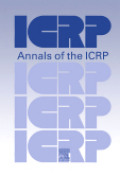
ICRP publication 118: ICRP statement on tissue reactions and early and late effects of radiation in normal tissues and organs - threshold doses for tissue reactions in a radiation protection context v. 41 issues 1-
This report provides a review of early and late effects of radiation in normal tissues and organs with respect to radiation protection. It was instigated following a recommendation in ICRP Publication 103 (2007), and it provides updated estimates of 'practical' threshold doses for tissue injury defined at the level of 1% incidence. Estimates are given for morbidity and mortality endpoints in all organ systems following acute, fractionated, or chronic exposure. The organ systems comprise the haematopoietic, immune, reproductive, circulatory, respiratory, musculoskeletal, endocrine, and nervous systems; the digestive and urinary tracts; the skin; and the eye. Particular attention is paid to circulatory disease and cataracts because of recent evidence of higher incidencesof injury than expected after lower doses; hence, threshold doses appear to be lower than previously considered. This is largely because of the increasing incidences with increasing times after exposure. In the context of protection,it is the threshold doses for very long follow-up times that are the most relevant for workers and the public; for example, the atomic bomb survivors with 40-50 years of follow-up. Radiotherapy data generally apply for shorter follow-up times because of competing causes of death in cancer patients, and hence the risks of radiation-induced circulatory disease at those earlier times are lower. A variety of biological response modifiers have been used to help reducelate reactions in many tissues. These include antioxidants, radical scavengers, inhibitors of apoptosis, anti-inflammatory drugs, angiotensin-converting enzyme inhibitors, growth factors, and cytokines. In many cases, these give dosemodification factors of 1.1-1.2, and in a few cases 1.5-2, indicating the potential for increasing threshold doses in known exposure cases. In contrast, there are agents that enhance radiation responses, notably other cytotoxic agents such as antimetabolites, alkylating agents, anti-angiogenic drugs, and antibiotics, as well as genetic and comorbidity factors. Most tissues show a sparing effect of dose fractionation, so that total doses for a given endpoint are higher if the dose is fractionated rather than when given as a single dose. However, for reactions manifesting very late after low total doses, particularly for cataracts and circulatory disease, it appears that the rate of dose delivery does not modify the low incidence. This implies that the injury in these cases and at these low dose levels is caused by single-hit irreparable-type events. For these two tissues, a threshold dose of 0.5 Gy is proposed herein for practical purposes, irrespective of the rate of dose delivery, and future studies may elucidate this judgement further. INDICE: GUEST EDITORIAL PART I: ICRP STATEMENT ON TISSUE REACTIONS PART II: EARLY AND LATE EFFECTS OF RADIATION IN NORMAL TISSUES AND ORGANS - THRESHOLDDOSES FOR TISSUE REACTIONS IN A RADIATION PROTECTION CONTEXT ABSTRACT PREFACEEXECUTIVE SUMMARY GLOSSARY 1. INTRODUCTION 1.1. Purpose of report 1.2. Definition and nature of tissue reactions to ionising radiation 1.3. General principles of radiation effects in cells and tissues 1.4. References 2. RESPONSE OF TISSUES AND ORGANS TO RADIATION 2.1. Haematopoietic and immune systems 2.2. Digestive system 2.3. Reproductive system 2.4. Skin 2.5. Cardiovascular and cerebrovascular systems 2.6. Eye 2.7. Respiratory system 2.8. Urinary tract 2.9. Musculoskeletal system 2.10. Endocrine system 2.11. Nervous system 2.12. References 3. MODIFIERS OF NORMAL TISSUE RESPONSE 3.1. Terminology 3.2. Mechanisms ofaction 3.3. Influence of modifiers on radiation response in tissue 3.4. References 4. THRESHOLD DOSES IN RELATION TO RADIOSENSITIVITY OF ORGANS AND TISSUES4.1. Introduction 4.2. Haematopoietic and immune systems 4.3. Digestive system 4.4. Reproductive system 4.5. Skin 4.6. Cardiovascular and cerebrovascular systems 4.7. Eye 4.8. Respiratory system 4.9. Urinary tract 4.10. Musculoskeletal system 4.11. Endocrine system 4.12. Nervous system 4.13. Conclusions 4.14. References ANNEX A. SUMMARY OF STUDIES OF EXPOSURE AND OPACITIES OR CATARACTS
- ISBN: 978-0-7020-5227-9
- Editorial: Saunders
- Encuadernacion: Rústica
- Páginas: 304
- Fecha Publicación: 01/05/2012
- Nº Volúmenes: 1
- Idioma: Inglés
